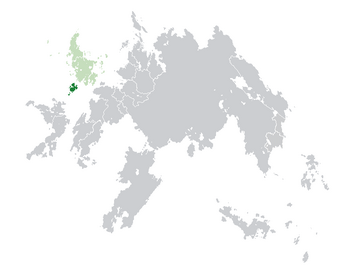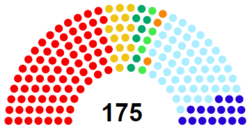User:Glitter/Crethia: Difference between revisions
m (1 revision imported) |
|
(No difference)
| |
Revision as of 19:03, 8 July 2019
Republic of Crethia Refoli af Krøtin | |
|---|---|
| Motto: "Til mi Fædrelande" "For My Fatherland" | |
 Crethia (green) located in Northern Nordania. | |
| Capital and largest city | Dunhaven |
| Official languages | Crethian |
| Recognised regional languages | Lyonese |
| Ethnic groups | Crethian (88.3%) Lyonese (5.6%) Other (6.1%) |
| Demonym(s) | Crethian, Crethish |
| Government | Federal parliamentary republic |
• President | Mary Hall |
• Prime Minister | Craig Kerr |
| Legislature | Parliament |
| Establishment | |
• Unification | 1548 |
• Crethian Civil War | 1832 |
• Republic established | 1836 |
• Constitution ratified | 1837 |
| Population | |
• 2016 estimate | 18,200,000 |
• 2014 census | 18,093,649 |
| GDP (nominal) | 2015 estimate |
• Total | 701.3 billion |
• Per capita | 39,862 |
| Gini (2015) | 23.7 low |
| HDI (2015) | 0.934 very high |
| Currency | Stirling (CSL) |
| Date format | dd-mm-yy |
| Driving side | left |
| Calling code | +21 |
Crethia (Crethian: Krøtin), officially the Republic of Crethia (Crethian: Refoli af Krøtin), is a country in Nordania. It borders Ambrose to the north, Austrosia to the west, Lyonsland to the south, and Lanos to the east. Crethia is a large country, with an area of square kilometres. It has a population of 18.2 million and a low population density of inhabitants per square kilometre. Most of the population is located in urban centers on the banks of the River Hvid and the River Til, with approximately 75% of the country residing in urban areas.
Celtic people have first settled in Crethia after migrating from neighboring Lyonsland, with the Albi tracing their ancient origins back to the Lyonese Celts. The Albi were a tribal people and established early confederations throughout modern day Crethia. Over time, Anglo-Saxons from the southeast conquered the Albini lands and established their own petty kingdoms. Over time a cultural fusion resulted in the Crethian culture and language. The Crethian petty kingdoms were united in 1548 under the banner of King Alexander II, who established the Kingdom of Crethia. In 1832, a succession crisis erupted into a violent civil war which ended with the establishment of a republic. The country saw significant industrialization and urbanization during the late nineteenth century. Since its civil war, Crethia has generally been at peace and pursues an official policy of neutrality. During the Esquarian Cold War, it generally supported the Northern Sea Defense Organization and implemented policies of conscription, which are still in place. It has since pursued membership in the Nordanian League. A bid for membership in the Esquarian Community was launched in the late 1990s, but failed when at vote in a referendum.
Crethia is a federal parliamentary republic, consisting of twelve provinces. The capital is Dunhaven, which has an urban population of 944,667 people. The current president is Mary Hall, an Independent, who serves as head of state. Executive power is exercised by the Government, which is led by the Prime Minister, a post currently held by Craig Kerr (PKR), and the Cabinet. Legislative power is vested in the unicameral Parliament. Each province has its own legislature and a provincial governor, which exercise developed authority.
Etymology
The name Crethia has its origins in the Gaelic name for the Albi people, Cruthaen. It is generally accepted that Cruthaen is the Goidelic version of Critani, which is the Britonnic name for the most powerful ancient Albi confederation. From Cruthaen, the Crethian Krøtin was derived. Crethia is the anglicized version of Krøtin.
History
Early history
The Seven Crowns
Unification and Kingdom of Crethia
Civil War
Republic and industrialization
Modern history
Politics
Governance
The governing doctrine of Crethia is its Constitution, which was drafted and ratified in 1837. It defines the federal system used to govern Crethia. It establishes three branches: the executive, legislative, and judicial branches. Likewise, it outlines the roles of provinces and their devolved branches of government.
The executive branch consists of the president, the prime minister, and the cabinet. The president is the head of state, meaning the role is largely ceremonial. The current President is Mary Hall, an Independent, and has held the post since 2015. Terms last for five years and presidents are popularly elected using a plurality vote. Typically, president's three primary tasks are conducting official state visits, receiving diplomatic credentials, and formally appointing the prime minister, cabinet, and other federal positions. However, all of these roles are filled by the government in the legislature. The largest party, or coalition of parties, in Parliament form the government. The prime minister, the head of government, is chosen from among the MPs and puts together his or her cabinet. Craig Kerr is the current prime minister and is a member of the Progressive Conservative and Republican Party. He has served as prime minister since the 2014 general election. Likewise, prime ministers nominate candidates to fill all federal posts, including those in the judiciary and various federal agencies. At least 75% of cabinet ministers must be sitting MPs and serve at the pleasure of the prime minister. Ministers oversee the fourteen federal departments.
 |
|
Government (87) Progressives (PKR) (69) National Alliance (NA) (18) Supported by Farmers' Party (La) (4) Opposition Social Democrats (S) (58) Liberal Party (Li) (18) Green Party (G) (7) Lyonese Interest Party (LIP) (1) |
The Parliament of Crethia (Folketing af Krøtin) is the federal legislature and is unicameral. It has 175 members known as Members of Parliament who are elected through proportional representation. MPs serve a maximum four year terms and then it is mandated by the Constitution that fresh elections must be held. Snap elections may be held between the regularly scheduled elections. Federal elections always take place on the first Wednesday of September and under Crethian law voting is mandatory. Election day is also a federal holiday and is observed throughout the country in order to make it easier for citizens to comply with the mandate. There is a 5% threshold for parties to achieve representation in Parliament. In total, there are 175 seats, 88 of which are needed for a majority. Seats can be adjusted after the census if the government deems it necessary. Traditionally, for every 100,000 citizens there is one seat in Parliament. Currently there is a minority coalition between the Progressive Conservative and Republican Party and the National Alliance. The government is supported by the Farmers' Party. The Speaker of the Parliament presides over the legislature and is responsible for ensuring the agenda is kept. The government is always seated to the speaker's left. After the government is seated, parties are placed according to their location on the political spectrum from the speaker's left to right. The legislature is housed in the Folketing-Hos, located in Dunhaven.
The judicial branch at a national level is made up of various levels of federal courts. The highest court of Crethia is known as the Landsret. It has appellate jurisdiction over all federal courts and over provincial court cases involving issues of federal law, plus original jurisdiction over a small range of cases. The Landsret alone has the final say on constitutionality, although it may only act within the context of a case for which it has jurisdiction. There are seven judges, known as Dommere (sin. dommer), that serve on the court. It is presided over by the Vigtigste Dommer while the remaining six judges are known as Medarbejderske-Dommere. They are appointed by the Furste and confirmed by Parliament. Once appointed, dommere have life tenure unless they resign, retire, or are removed after impeachment. Other national courts are known as Folkesret. The country is divided into five circuits, officially known as Folkesrondrejse. Provinces are grouped into circuits based on population, and jurisdiction may change with each census.
Political parties and elections
Administrative divisions
As a federal republic, Crethia is divided into twelve provinces, known in Crethian as område. Each province has its own constitution, governor, and legislature. Devolved powers are granted to the provinces and their standing is made permanent by the 1837 constitution. Provincial legislatures differ in the organization, which is laid out in the constitution of each individual province. Each province is required to maintain an official flag and coat of arms, which it reserves the right to alter or replace by passing legislation. Provinces in the Flodlande (Riverlands) region of the country tend to be densely populated, while those in the Udrelande (Outerlands) are sparsely populated. Many of the provincial borders are rooted in the borders of the old counties, the former subdivisions of the Kingdom of Crethia. Many have been condensed into larger provinces, while some such as Kragesborg and Leteborg maintain their old borders.
| Map | Name and shield | Administrative centre | Most populous municipality | Population | |
|---|---|---|---|---|---|
| Template:Crethia labelled map | Province (område) | ||||
| Blare | Clud | 1,706,584 | |||
| Harborg | Harborg | 1,935,301 | |||
| Tilvæg | Tilvæg | 2,814,983 | |||
| Robertebur | Robertebur | 211,123 | |||
| Klitte | Klitte | 598,184 | |||
| Dunhaven | Dunhaven | 3,694,667 | |||
| Fiv | Hjeme | 623,155 | |||
| Heteslande | Heteslande | 510,216 | |||
| Melkirke | Melkirke | 228,717 | |||
| Invermose | Rokesburg | 2,639,047 | |||
| Angulborg | Duntopmøde | 140,749 | |||
| Strat | Dunbroke | 2,990,920 | |||
Demographics
The first Celtic people arrived in Crethia following the migration of early Lyonese Celts northward. The Albi were the first native Celtic group and lived in modern day Crethia exclusively until Anglo-Saxons from Arkiasis conquered the region in the early eleventh century. Over time, a fusion of the native Albi and the Anglo-Saxon cultures and ethnic groups occurred, resulting in the creation of the modern day Crethian people. The Crethian language also has its origins in this cultural fusion. As such, Crethia is considered a Celto-Germanic state. When discussing Crethian culture, one prominent academic said that it is "Celtic when convenient, and Germanic when convenient".
Today, roughly 88% of the population identifies as ethnically Crethian as of the 2014 census. The biggest minority group within Crethia is Lyonese, with 5.6% of the population identifying as such. The majority of the Lyonese population, which as of 2014 is 985,244, resides within the province of Leteborg, which has historically exchanged hands between Lyonsland and Crethia. In recent years, Lyonese political movements have been launched, with the most notable being the Lyonese Interest Party. Other significant ethnic groups are Teutonic and Lanosian.
| Rank | Province | Pop. | |||||||
|---|---|---|---|---|---|---|---|---|---|
| Dunhaven Dunhaven  Moseskove |
1 | Dunhaven | Dunhaven-Moseskove | 944.667 |  Rokesborg  Tilvæg | ||||
| 2 | Moseskove | Dunhaven-Moseskove | 635.606 | ||||||
| 3 | Rokesborg | Leteborg | 524.035 | ||||||
| 4 | Tilvæg | Kragesborg | 342.021 | ||||||
| 5 | Invermose | Leteborg | 226.451 | ||||||
| 6 | Dunbroke | Stratborg | 214.112 | ||||||
| 7 | Harborough | Sudlande | 201.462 | ||||||
| 8 | Stenhvid | Stratborg | 200.276 | ||||||
| 9 | Clud | Blareborg | 182.788 | ||||||
| 10 | Inverkombu | Kragesborg | 173.349 | ||||||





